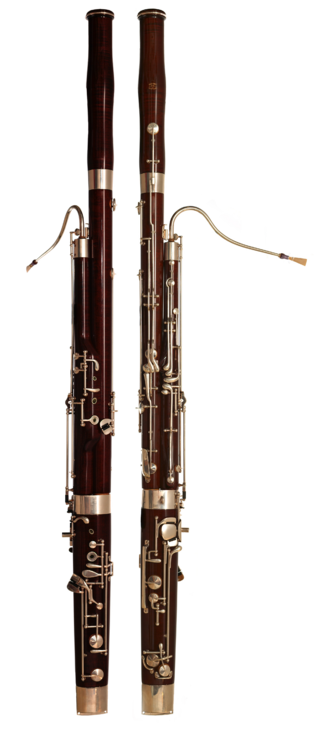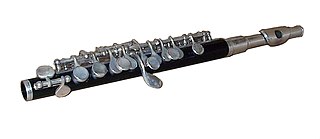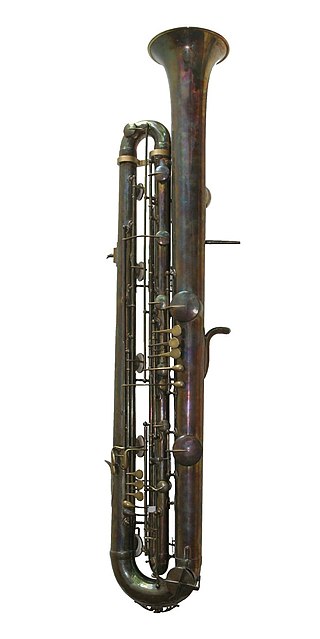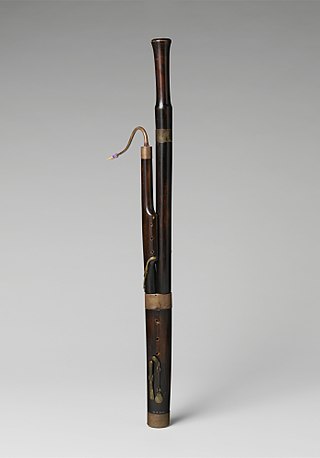
The bassoon is a musical instrument in the woodwind family, which plays in the tenor and bass ranges. It is composed of six pieces, and is usually made of wood. It is known for its distinctive tone color, wide range, versatility, and virtuosity. It is a non-transposing instrument and typically its music is written in the bass and tenor clefs, and sometimes in the treble. There are two forms of modern bassoon: the Buffet and Heckel systems. It is typically played while sitting using a seat strap, but can be played while standing if the player has a harness to hold the instrument. Sound is produced by rolling both lips over the reed and blowing direct air pressure to cause the reed to vibrate. Its fingering system can be quite complex when compared to those of other instruments. Appearing in its modern form in the 19th century, the bassoon figures prominently in orchestral, concert band, and chamber music literature, and is occasionally heard in pop, rock, and jazz settings as well. One who plays a bassoon is called a bassoonist.
The clarinet is a single-reed musical instrument in the woodwind family, with a nearly cylindrical bore and a flared bell.

The oboe is a type of double-reed woodwind instrument. Oboes are usually made of wood, but may also be made of synthetic materials, such as plastic, resin, or hybrid composites.

The saxophone is a type of single-reed woodwind instrument with a conical body, usually made of brass. As with all single-reed instruments, sound is produced when a reed on a mouthpiece vibrates to produce a sound wave inside the instrument's body. The pitch is controlled by opening and closing holes in the body to change the effective length of the tube. The holes are closed by leather pads attached to keys operated by the player. Saxophones are made in various sizes and are almost always treated as transposing instruments. A person who plays the saxophone is called a saxophonist or saxist.

The piccolo is a half-size flute and a member of the woodwind family of musical instruments. Sometimes referred to as a "baby flute" or piccolo flute, the modern piccolo has the same type of fingerings as the standard transverse flute, but the sound it produces is an octave higher. This has given rise to the name ottavino, by which the instrument is called in Italian and thus also in scores of Italian composers.

The sarrusophones are a family of metal double reed conical bore woodwind instruments patented and first manufactured by French instrument maker Pierre-Louis Gautrot in 1856. Gautrot named the sarrusophone after French bandmaster Pierre-Auguste Sarrus (1813–1876), whom he credited with the concept of the instrument, though it is not clear whether Sarrus benefited financially. The instruments were intended for military bands, to serve as replacements for oboes and bassoons which at the time lacked the carrying power required for outdoor marching music. Although originally designed as double-reed instruments, single-reed mouthpieces were later developed for use with the larger bass and contrabass sarrusophones.
The contrabassoon, also known as the double bassoon, is a larger version of the bassoon, sounding an octave lower. Its technique is similar to its smaller cousin, with a few notable differences.
Contrabass refers to several musical instruments of very low pitch—generally one octave below bass register instruments. While the term most commonly refers to the double bass, many other instruments in the contrabass register exist.

The contrabass clarinet (also pedal clarinet, after the pedals of pipe organs) and contra-alto clarinet are the two largest members of the clarinet family that are in common usage. Modern contrabass clarinets are transposing instruments pitched in B♭, sounding two octaves lower than the common B♭ soprano clarinet and one octave below the bass clarinet. Some contrabass clarinet models have extra keys to extend the range down to low written E♭3, D3 or C3. This gives a tessitura written range, notated in treble clef, of C3 – F6, which sounds B♭0 – E♭4. Some early instruments were pitched in C; Arnold Schoenberg's Fünf Orchesterstücke specifies a contrabass clarinet in A, but there is no evidence such an instrument has ever existed.

The tubax is a modified contrabass saxophone developed in 1999 by the German instrument maker Benedikt Eppelsheim. Although it has the same fingering as the saxophone, Eppelsheim's design reduces the amount of expansion of its conical bore in relation to the length of tubing, resulting in a smaller volume of resonant air column. This allows for it to use a smaller mouthpiece, and more compactly folded tubing. The tubax exists in E♭ contrabass and B♭ or C subcontrabass sizes. Its name is a combination of the words "tuba" and "saxophone".

The soprillo is the smallest saxophone, developed as an extension to the saxophone family in the late 1990s by German instrument maker Benedikt Eppelsheim. It is 33 cm (13 in) long including the mouthpiece, and pitched in B♭ one octave above the soprano saxophone.

The subcontrabass saxophone is the largest of the family of saxophones that Adolphe Sax described in his 1846 patent. He called it the saxophone bourdon, named after the very low-pitched 32′ bourdon pedal stop on large pipe organs. Although Sax planned to build one, the first playable instrument was only built in 2010. It is a transposing instrument pitched in B♭ one octave below the bass saxophone, two octaves below the tenor, and three octaves and a major second below its written pitch.

The contrabass saxophone is the second-lowest-pitched extant member of the saxophone family proper. It is pitched in E♭ one octave below the baritone saxophone, which requires twice the length of tubing and bore width. This renders a very large and heavy instrument, standing approximately 2 metres tall and weighing around 20 kilograms (44 lb). Despite this, it was used in marching bands in the early 20th century.

The sopranino saxophone is the second-smallest member of the saxophone family. It is tuned in the key of E♭, and sounds an octave higher than the alto saxophone. A sopranino in F was also described in Adolphe Sax's patent, an octave above an F alto (mezzo-soprano), but there are no known built instruments.
Benedikt Eppelsheim was a German instrument maker of extreme high- and low-voiced woodwind instruments. He lived in Munich, Germany

The contrabass sarrusophone is the deepest of the family of sarrusophones, built in three sizes pitched in E♭, C or B♭. It was made in the 19th and early 20th centuries, primarily in France by its inventor and Parisian instrument maker Pierre-Louis Gautrot and his successor Couesnon & Co., and Evette & Schaeffer. It was also made in Italy by Milan manufacturers Romeo Orsi and Rampone & Cazzani, and in the United States by C. G. Conn, who built instruments in E♭ for US military bands. Romeo Orsi and the German instrument maker Benedikt Eppelsheim make individual contrabass sarrusophones on request.

The tenor bassoon or tenoroon is a member of the bassoon family of double reed woodwind instruments. Similar to the alto bassoon, also called octave bassoon, it is relatively rare.
Guntram Wolf was a maker of modern and historical woodwind instruments in Kronach, Germany.

The Lupophon is an extremely rare woodwind instrument in the oboe family that plays in a lower pitch than standard, and was developed by Guntram Wolf of Kronach and Benedikt Eppelsheim of Munich, Germany, manufactured by Guntram Wolf. The instrument takes its name after the Italian translation of the inventor's surname, as the sarrusophone, the saxhorn, the saxophone, the heckelphone, and the rothphone are named after their inventors. It is in effect a modified heckelphone, with a slightly smaller bore and range down to low F. The lower portion of the instrument is folded back on itself in order to manage the considerable length of the tube, somewhat in the manner of a saxophone. The addition of the four lowest semitones allows it to cover the full intended range of the heckelphone part of Richard Strauss' Eine Alpensinfonie, which descends beyond that instrument's lowest note.

The Akademiemodel Wiener oboe, commonly referred to as the Wiener oboe or Viennese oboe, is a type of modern oboe first developed in the 1880s by Josef Hajek. The design of the Wiener oboe retains the essential bore and tonal characteristics of the historical oboe. The Wiener oboe is named after its origins in Vienna and, besides the more common Conservatoire oboe, is the only other type of modern oboe in use today.















